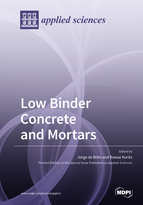Low Binder Concrete and Mortars
A special issue of Applied Sciences (ISSN 2076-3417). This special issue belongs to the section "Materials Science and Engineering".
Deadline for manuscript submissions: closed (31 December 2019) | Viewed by 71267
Special Issue Editors
Interests: CIB—International Council for Research and Innovation in Building and Construction; durability of building elements, maintenance of buildings; rehabilitation of buildings; building life cycle assessment
Special Issues, Collections and Topics in MDPI journals
2. Department of Highway and Bridge Engineering, Technical Engineering College, Erbil Polytechnic University, Erbil 44001, Iraq
Interests: environmental impact; materials science; life cycle assessment; geopolymer concrete; green concrete; Alkali-activated materials; supplementary cementitious materials; construction and demolition waste; Sustainable concrete and mortar; Costs (economy); multi-criteria analysis; optimization
Special Issues, Collections and Topics in MDPI journals
Special Issue Information
Dear Colleagues,
It is well known that after water, concrete and mortars are the most demanded materials worldwide. Therefore, they have a significant influence on environmental impacts (EI), namely, because of their cement content. Thus, many alternative materials such as supplementary cementitious materials have been proposed to be used in order to decrease the EI of mortar and concrete. However, studies regarding extremely low binder content, namely, cement, are still very scarce.
This Special Issue of Applied Sciences provides a forum for original studies and comprehensive reviews on the technical performance (e.g., mechanical and durability), economics, and EI (e.g., global warming and energy consumption) of concrete and/or mortar containing low binder content. In other words, any attempts or techniques, i.e., using any type of supplementary cementitious materials, alkali activation (e.g., geopolymers), strengthening systems (e.g., fibers), by-product nano materials, additives, etc., that help to decrease the cement content of concrete and mortars, are welcome.
Prof. Dr. Jorge de Brito
Dr. Rawaz Kurda
Guest Editors
Manuscript Submission Information
Manuscripts should be submitted online at www.mdpi.com by registering and logging in to this website. Once you are registered, click here to go to the submission form. Manuscripts can be submitted until the deadline. All submissions that pass pre-check are peer-reviewed. Accepted papers will be published continuously in the journal (as soon as accepted) and will be listed together on the special issue website. Research articles, review articles as well as short communications are invited. For planned papers, a title and short abstract (about 100 words) can be sent to the Editorial Office for announcement on this website.
Submitted manuscripts should not have been published previously, nor be under consideration for publication elsewhere (except conference proceedings papers). All manuscripts are thoroughly refereed through a single-blind peer-review process. A guide for authors and other relevant information for submission of manuscripts is available on the Instructions for Authors page. Applied Sciences is an international peer-reviewed open access semimonthly journal published by MDPI.
Please visit the Instructions for Authors page before submitting a manuscript. The Article Processing Charge (APC) for publication in this open access journal is 2400 CHF (Swiss Francs). Submitted papers should be well formatted and use good English. Authors may use MDPI's English editing service prior to publication or during author revisions.
Keywords
- Concrete and mortar technology
- Sustainable development
- Supplementary cementitious materials
- Nano-materials
- Alkali activation–polymer composites
- Concrete admixtures
- Fiber-reinforced concrete
- Life cycle assessment
- Costs







